In 2021, Portland became the largest modern U.S. city to end so-called “single-family zoning.” What follows here is a history of how the residential infill project could have died but didn’t. This history was developed in partnership with Lincoln Institute of Land Policy. See also our 10 tips for zoning reformers, which serve as a short summary of the narrative below.
It was January 2020. One of Oregon’s most respected economists looked over a crowd of 400 people at the state’s annual Housing Economic Summit and told a familiar story about zoning.
Mike Wilkerson, of the consulting firm ECONorthwest, mentioned something he said had happened the previous night: the first city council hearing for Portland’s “Residential Infill Project,” a proposal to legalize up to four homes on almost any residential lot in the state’s largest city. “There were a line of people out the door and the comments were generally revolving around the character of the neighborhood, et cetera,” said Wilkerson.
It was a reasonable story to tell—a story told a thousand times by a hundred years of zoning hearings across the United States, Canada, and around the world.
But Wilkerson was wrong. Somehow, this time it hadn’t gone like that.
The economist was right about the line out the door at Portland City Hall the previous evening. But at the crucial public hearing for one of the farthest-reaching zoning reforms in U.S. history, the line out the door had consisted almost entirely of people urging the city to pass it.
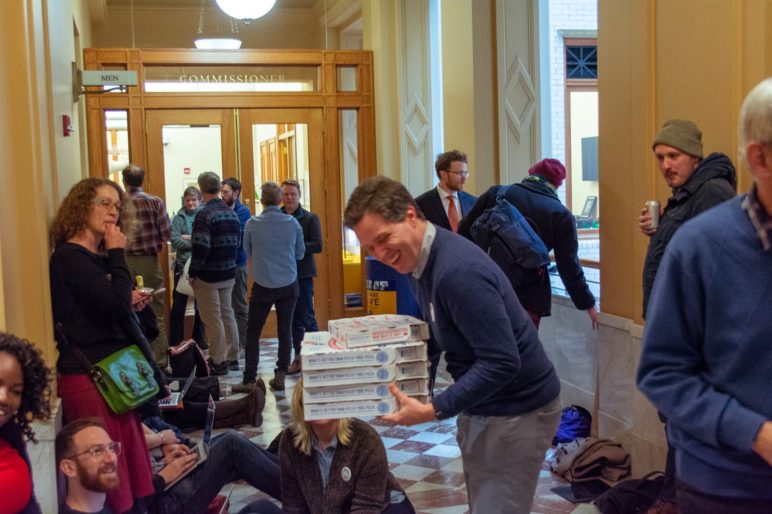
Housing advocates wait in line to sign up for testimony on the Residential Infill Project at Portland City Hall, January 2020. (The food, courtesy of Pizza to the Polls, was also offered to opponents of the proposal.)
Wilkerson had been so certain that any major zoning reform hearing would always be dominated by anti-housing activists that he hadn’t bothered to check.
Over two nights of hearings in January 2020, the in-person public commentary came to 106 in favor of pro-housing reform and 30 opposed. Joining the dozens of individuals in support were affordable housing developers like Hacienda Community Development, stable-housing advocates like the Cully Housing Action Team, environmentalists like Sunrise PDX, quality-of-life advocates like AARP Oregon, civic groups like the Northeast Coalition of Neighborhoods, and transportation reformers like Oregon Walks.
The effect on Portland’s four-person city council was immediate and decisive. Two left-aligned commissioners who’d been publicly withholding support for the proposal all but endorsed it on the spot, with the addition of further amendments called for by the pro-housing testimony.
The result was an unprecedented reform, legalizing up to four homes by right on almost any residential lot in the nation’s 26th largest city. It also legalized three-story apartment buildings of up to six homes on any lot if at least half met affordability standards. And Portland became the fifth large U.S. city to effectively remove residential parking mandates citywide.
Time will tell how many homes will result from Portland’s Residential Infill Project. Portland’s most optimistic projection of the short-term impact comes out to 1,200 net additional homes per year, enough to increase the city’s annual housing production by roughly 20 percent. An outside analysis by economists working with the national housing advocacy organization Up for Growth estimated that over the long term, the median Portland rent will be 12 percent lower than it would have been without the reform, an annual savings of $3,000 for the average tenant.
Whatever may or may not get built, there is no question that this reform’s unlikely five-year journey to passage offers political lessons for similar cities pursuing zoning and policy changes.
The Residential Infill Project is a project that could have easily died on eight separate occasions, but never did.
This is the story of what it took, and who it took, to give nine lives to a good idea.
Death #1: The proposal is never even developed
Prevented by a NIMBY campaign that was turned around
Maybe the easiest way for Portland’s reform to have failed would have been for it to meet the same fate as almost every other potential reform to low-density zoning for the last 50 years: It might have never existed.
The fact that it did is thanks to a NIMBY campaign against infill housing—and a handful of infill supporters inside and outside city government who turned that campaign into Pandora’s Box.
Portland, Oregon, had been a regional hub of a dwindling resource-extraction economy from the 1950s until the late 1980s, when a long migration-powered population growth trend began.
In 2009 and 2010, the Portland metro area’s rental vacancy rate was already lower than any other in the nation, according to census estimates. In 2011 and 2013, it ranked second in the United States. And in 2009, 2010 and 2011, the Portland metro area (like most others around the country) added very few new homes. This meant that when significant money and new jobs started pouring into the Portland area in 2013, the region was primed for a huge surge in home prices.
From 2013 to 2018, Portland’s real median rent rose 29 percent, an additional annual cost of $3,120 to the median renter. In the same period, real median home prices rose 46 percent, an additional $146,000. In 2015, a city study found that there was no longer a single neighborhood in Portland where the median Black or Native American household in the area could afford the costs of owning the median home. The following year, this also became true of the median Latino, senior, and single-mother households.
Those rising home prices, in turn, drove two other trends: a spike in demolitions and renovations of one-unit buildings; and a simultaneous wave of new mixed-use apartments built along commercial streets that had been zoned for four- to six-story apartment buildings.
All these changes led to a surge of activity in two mostly unrelated grassroots organizations starting in 2014. One, opposed to rent hikes, was led by tenants who gathered in a Facebook group called “PDX Renters Unite.” The other, opposed to new buildings in the city’s most expensive neighborhoods, was led by homeowners who gathered in a Facebook group called “Stop Demolishing Portland.”
It was the homeowners’ group that was the first to find somewhat sympathetic ears at City Hall. Mayor Charlie Hales, who directly oversaw the city’s planning bureau, began talking with planners in 2015 about what was to be done.
But the city’s top planners simply didn’t agree that demolitions of old one-unit homes were, in themselves, a big problem.
“A city needs to have reinvestment in its housing stock,” says Joe Zehnder, who oversaw long-range planning for the city throughout the project. “Having reinvestment, even if that entails demolition, isn’t inherently a bad thing.”
After months of trying to stave off questions about how to respond to homeowners’ complaints, Zehnder says, the city planning staff “pivoted.” Zehnder and his boss, Susan Anderson, pitched Hales on a rezoning proposal that would consider not only the complaints about large new homes—McMansions, some called them—but also proposals to allow more small housing options, like duplexes and triplexes, in low-density areas.
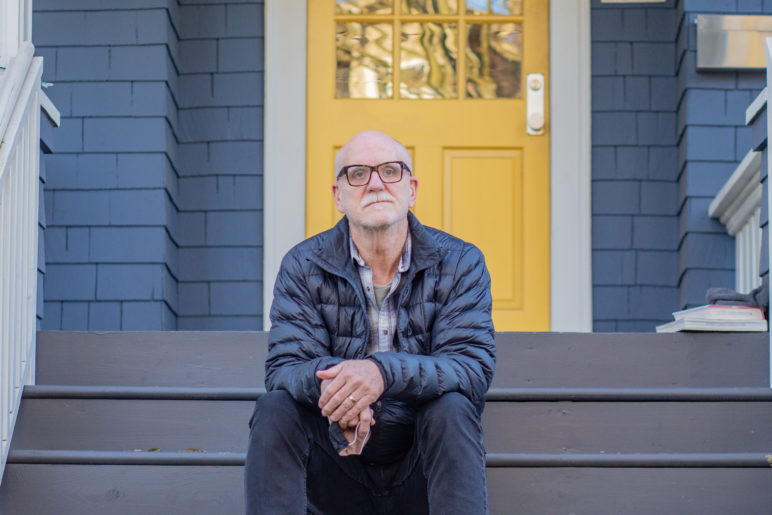
Joe Zehnder, chief planner for the Portland Bureau of Planning and Sustainability, outside his Portland home. Photo copyright Kayla Brock for Sightline.
There was a logic to it. In a city of rising wealth, single-unit detached zoning channeled capital and development toward a single product: mansions. By ending single-detached zoning, the city could channel private investment toward smaller attached homes instead.
The year before, Zehnder had received a letter from a coalition of interest groups asking for various tweaks to the rules for backyard cottages and internal divisions of large homes into multiple smaller units. He and Anderson saw it as a possible way to advance the city’s goals for carbon reduction and increased housing supply.
“We knew we needed to get more out of the single-family zoned places, too,” says Zehnder. “I knew those voices were around, and this was an opening.”
Death #2: Infill advocates fail to organize early
Prevented by a mayoral aide and a handful of advocates
Zehnder’s and Anderson’s pitch worked. But even as they pitched it, Zehnder says, he knew any change to relatively wealthy, homeowner-dominated neighborhoods would be a colossal fight.
“Anything big takes an outside game or it just won’t get over the finish line,” says Zehnder, drawing on his experience as a planner in Baltimore and Chicago. “But man, this was beyond an outside game. This was a different level. … I didn’t see how you would get there.”
Someone in the Portland mayor’s office did. Jackie Dingfelder, Mayor Hales’ policy director, started thinking about the politics of zoning reform in well-off neighborhoods.
In April 2015, three months before a citizen advisory committee was to be selected, Dingfelder called a meeting with a few people she thought might want to start building the “outside game”—a political advocacy campaign that wasn’t part of city government—for what was then the far-fetched notion of a major reform to low-density zones.

Jackie Dingfielder, former policy director for Mayor Charlie Hales, outside her home. Photo copyright Kayla Brock for Sightline.
A former environmental champion in the state legislature with a planning degree of her own, Dingfelder biked five miles to City Hall every weekday morning from a 1924 house in the Rose City Park neighborhood. Since the year it had been built, her own neighborhood had been a hub of homeowner-led resistance to even mid-density housing.
“You’re going to be skewered by the opponents,” she says in a 2020 interview. “This can’t come from the top. This has to be something that the community supports.”
Three of the people that came to Dingfelder’s office were board members for one of her old legislative allies, the anti-sprawl nonprofit 1000 Friends of Oregon: Portland State University planning professor Dr. Lisa Bates, planning consultant Nolan Lienhart, and car-sharing entrepreneur Steve Gutmann. The fourth was someone they’d invited along, a developer of small-scale housing projects named Eli Spevak.
Spevak had built a career in Portland’s affordable-housing industry, working for Habitat for Humanity and then as a technical consultant for other affordable homeownership projects. Along the way, he’d started piecing together small market-rate and mixed-income projects of his own.
“It was just trying to create good housing for me and my friends that motivated me to be a developer,” Spevak says.
Spevak moved into his own first project, a renovated sixplex, in 2004. One of his neighbors there, Amy Stork, introduced him to fun, civically-themed group bike rides. Annoyed by high-profile car tours of huge homes marketed as “green,” Spevak started leading bike rides to look at small homes around Portland.
In the midst of a 2014 fellowship to study the potential of small homes, Spevak had written and gathered signatures for the letter that Zehnder would remember later.
Spevak was fairly new to politics. But he took the meeting with Dingfelder as a call to action. He went home and fired up his email list.
Death #3: The city rounds up the usual homeowners for “community input”
Prevented by a connected developer and a mayoral aide
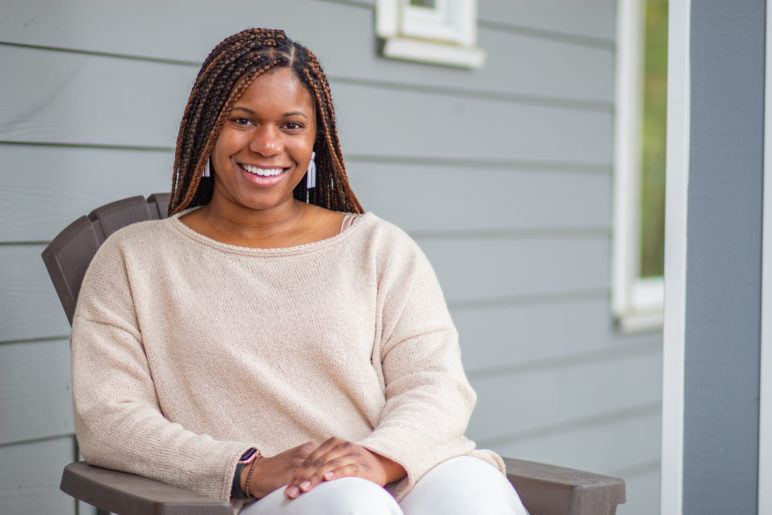
Camille Elmore-Trummer, former policy aide to Mayor Charlie Hales, outside her Portland home. Photo copyright Kayla Brock for Sightline.
Two months after the Dingfelder meeting, Spevak applied for a seat on the zoning reform advisory committee, assuming he’d get one. He was one of many who nearly didn’t.
Mayor Hales’ liaison to the city planning bureau was Camille Elmore-Trummer, a civic communications specialist. Elmore-Trummer had bonded with Hales while working on the city’s new comprehensive zoning plan.
Hales, Elmore-Trummer says, “fundamentally believed that we were on the path to creating more diverse homes” by reforming low-density zoning.
Elmore-Trummer’s own perspective was similar. “I was constantly reframing the conversation to be less about the housing stock and more about the people,” recalls Elmore-Trummer, who is Black, about conversations with homeowners skeptical about lifting bans on small attached homes. “You’re basically preventing folks from my generation from being able to live in your neighborhood. … You are saying that indigenous, Black, and brown communities should not have the opportunities that white people did.”
When Elmore-Trummer saw the initial list of advisory committee members proposed by the planning bureau, she says, she decided it wouldn’t do. It was thick with homeowner-dominated neighborhood associations but thin on anyone coming from other perspectives.
Douglas MacLeod, a small-scale developer, says he saw his name on an initial list with about nine other people on it. He was horrified.
“It was basically neighborhood association people [and] maybe, like, a nonprofit,” he recalls. “It was the same kind of stacked group that they’d been doing basically forever.”
“That led to revisiting applications and searching for other folks,” Elmore-Trummer says. “I was like, I need Eli Spevak.”
When the final list came out in August 2015, it had 26 names. Among them were Spevak, 1000 Friends deputy director Mary Kyle McCurdy, and representatives for Habitat for Humanity, Anti-Displacement PDX, the Portland State University Institute on Aging, the Energy Trust of Oregon, and the Immigrant and Refugee Community Organization. A few other small-scale homebuilders were on the list too.
In addition to pro-infill and anti-infill agitators, “we kind of brought in all these different ‘middle’ perspectives,” says Morgan Tracy, the city’s project manager.
Still absent, though: any representative focused specifically on the interests of tenants. Elmore-Trummer now says this is something she’d do differently if she had the chance.
“Property owners are always the obvious stakeholders,” says Sandra Wood, Tracy’s supervisor throughout the project. “The less obvious stakeholders [are] who is being denied opportunity. … We’ve learned a lot during this process.”
Death #4: The mayor guts the project before it launches
Prevented by the project manager and the advisory committee’s “progressive caucus”
Within a month of the committee’s first meeting, in late 2015, the importance of who got to be in the room became obvious.
The committee’s dynamics—a small group of infill lovers, a small group of infill haters, and various other people looking for their angle—mirrored those in the city at large. Committee members would soon strike a bargain that isolated and marginalized the handful of infill haters, setting the template for much of the debate to come.
David Sweet, Spevak’s next-door neighbor and the land-use chair for the Cully Association of Neighbors, was one of the neighborhood associations’ delegates. “Right from the second meeting, we gathered together the folks who we thought were ready to be more progressive,” Sweet recalls.

Residential Infill Project Stakeholder Advisory Committee members, and Portland for Everyone co-founders, David Sweet and Eli Spevak outside the duplex their families share. Photo copyright Kayla Brock for Sightline.
After each committee meeting, the pro-housing “progressive caucus” would reconvene at a pizza joint down the street. They discussed upcoming issues, who among them should mount which pro-housing arguments at the next meeting, and even where in the committee room they should each sit. The caucus began with Sweet, Spevak, McCurdy, Anti-Displacement PDX’s Danell Norby, and a few allies from other nonprofits. Then they recruited the development industry representatives, then others. Eventually, more than half the committee was in the secret club.
The bargain the “progressive caucus” agreed to pursue was simple: the maximum size of new buildings in low-density zones should go down, and the number of homes allowed within those buildings should go up.
Most of the developers hated a new cap on building size, and members differed on its details. But as a way to end single-family zoning, the size cap had big strategic benefits:
- It offered an intuitive response to complaints about “out of scale” homes.
- It reduced uncertainty about what infill would be like. By guaranteeing that each new duplex home on a standard lot could be no larger than 1,500 square feet, advocates could cite specific price estimates within the budget of many Portlanders who couldn’t otherwise afford a newly built home.
- It let housing advocates position themselves against McMansions. The size cap drove a wedge between two types of infill skeptics: those offended by wealth, and those offended by neighbors. Once the McMansion ban had satisfied anti-wealth skeptics, the anti-neighbor coalition revealed itself as both small and unsympathetic.
Tracy, the project manager, found this fragile compromise compelling. So it came as a surprise when Mayor Hales threatened to squash it.
Hales, battered by criticism about how the city should handle a surge of visible homelessness, announced in October 2015 that he was dropping out of his race for a second term. Around that time, Hales approached city staff with a proposal. He wanted the council to pass the less controversial parts of this project—in particular, the cap on building size—and legalize duplexes in a second, later phase.
Tracy immediately concluded that this would kill the whole plan.
“He wanted to come out with a win—have a conclusion to the project and show that he’d produced something,” Tracy says. What’s going to happen “later,” Tracy figured, is nothing.
Tracy told Mayor Hales that he would have to come to a committee meeting to pitch the idea himself. Then Tracy called up MacLeod, the small developer, to warn him about the mayor’s plan.
“It was clear that once the NIMBYs got what they wanted, you know, we’d lose negotiating power,” says MacLeod. “If you pulled the thread out, the whole thing would fall apart.”
MacLeod tipped off the rest of the “progressive caucus,” which swung into action. At the next meeting, Spevak was ready to lead the charge.
“Eli said, ‘Mr. Mayor, I think that’d be a pretty bad idea and the whole thing would collapse if you do this,'” MacLeod recalls. “And people just piled on.”
Hales slunk out of the meeting defeated. Tracy, the project manager, was relieved.
“That was a really pivotal moment, and if we’d bailed at that point, the project would have had a very different outcome,” Tracy says.
Death #5: NIMBYs spook the planning commission
Prevented by Madeline Kovacs and the Portland for Everyone campaign
As the advisory committee’s work wrapped up in early 2016, Spevak and Sweet were worried. The proposal was headed for a deep review by the city Planning and Sustainability Commission, which would recommend a final version to city council. They remembered Dingfelder’s warning that the project would fail if it seemed to be coming from the city government itself.
They also knew that because of the size cap, most developers would never be fully enthusiastic about the plan.
What Portland needed, they decided, was a popular pro-housing campaign. Spevak had an idea of who should lead it: his employee Madeline Kovacs.

Former Portland for Everyone coordinator Madeline Kovacs outside her Portland home. Photo copyright Kayla Brock for Sightline.
Kovacs had grown up middle-class in the San Francisco Bay area, living with her family in a shared house until her parents managed to buy one of their own. After college, she’d worked as an environmental organizer, co-founding a nonprofit and later becoming interested in the links between density and decarbonization while working with young climate journalists from around the world. That had led to graduate classes at Portland State University, an internship in Portland’s planning bureau and eventually a job researching policy, pushing paperwork, and solving problems as the top deputy for Spevak’s three-person development company.
Spevak says he’d been aware of Kovacs’ previous climate organizing and noticed her passion and range of skills while sharing an office with her.
On top of that, he says, Kovacs was “the sort of person that everybody likes.”
Spevak and Sweet approached McCurdy, their collaborator on the “progressive caucus,” with a proposal: that 1000 Friends of Oregon be the organizational home of a coalition called “Portland for Everyone,” a name Sweet had borrowed with permission from a similar campaign in Seattle. It would be staffed by half of Kovacs’ time and initially funded by about $30,000 Spevak and Sweet had raised from several developers and other donors.
Lienhart, a 1000 Friends board member who’d been at the Dingfelder meeting and often pushed for the organization to take a louder “anti-NIMBY” voice, said it was the opportunity he and his colleagues had been waiting for.
“Portland for Everyone seemed to come to the organization from Eli and Madeline, packaged better than anything we were saying,” recalls Lienhart.
So in summer 2016, Kovacs set up shop in a cubicle at 1000 Friends, armed with her contact list, Spevak’s, and McCurdy’s. What was first conceived as a two-month organizing gig grew; McCurdy’s boss Jason Miner decided to create a full-time payroll position for Kovacs to focus on pro-housing advocacy.
As Kovacs’ work began to draw media coverage, 1000 Friends faced a wave of accusations that the anti-sprawl group had sold out to a cabal of developers intent on total transformation of the city.
“We lost donors and members as a result of it, but it wasn’t a hard decision for us,” says McCurdy, who supervised Kovacs. “From the very beginning of 1000 Friends, this was our position.”
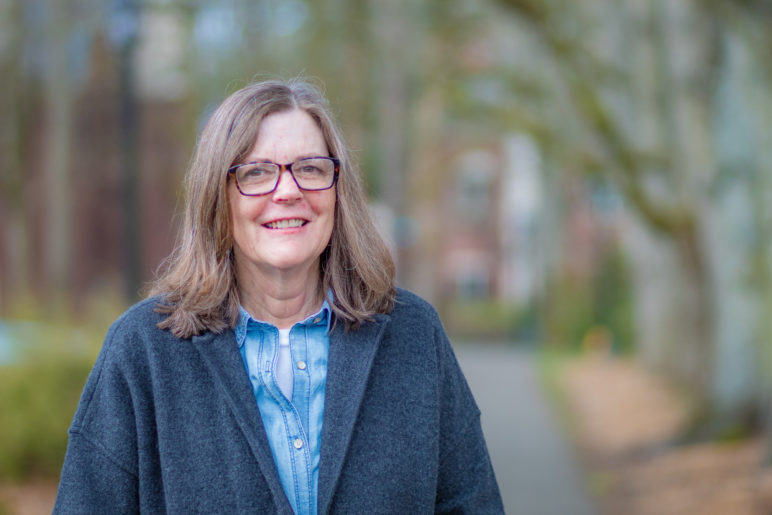
Mary Kyle McCurdy, policy director for 1000 Friends of Oregon, outside her Portland home. Photo copyright Kayla Brock for Sightline.
Kovacs decided that Portland for Everyone should be a loose-knit coalition, deliberately assembled from groups that often disagreed on details but could still come together to co-sign policy documents and official testimony.
“You can either have something that’s very formalized, where every coalition member has a vote on the structure of everything and every decision,” she says, “or you can have kind of an ad-hoc coalition where you have shared values and you share information and you agree to show up for something but you don’t really have a unified voice. And what we did was something sort of in the middle.”
In part to avoid any impression that Portland for Everyone was controlled by any single interest group—for-profit builders, nonprofit builders, environmentalists—Kovacs carefully metered the number of organizations of any given type that were invited to join the coalition at once.
An initially homogenous coalition, Kovacs calculated, would be unrepresentative and limited in perspective. It’d also perpetuate itself by making newcomers feel out of place. An eclectic coalition would feel welcoming.
“It also meant that we were taken really seriously by decision-makers,” Kovacs says. “Having home builders show up in lockstep with the urban forestry commission was pretty incredible.”
Portland for Everyone also hired a local freelance policy writer—Michael Andersen, the author of this case study—to spend four to eight hours a week keeping a “reported blog” about Portland housing news under the Portland for Everyone brand. They used the blog to build relationships with potential allies, to tell stories that became talking points with decision-makers, and to shape mainstream media coverage by covering news about the infill project faster and more clearly than anyone else. That effort also drove subscriptions to the campaign’s “action alerts” email list.
Finally, Kovacs and a team of eight volunteers set out to meet thousands of Portlanders face to face, often at neighborhood associations.
“These allowed people who didn’t agree with their neighborhood association’s leadership to speak up,” Kovacs later wrote. “So, often, even if we didn’t come away with a ‘yes,’ we still ended up either sparking a dialogue and neutralizing a few neighborhood associations, bringing out a previously-silent majority, and/or helped get the ball rolling for future neighborhood association leadership change.”
By summer 2018, when the project finally came before the city planning commission, Kovacs and her crew had spoken with 3,000 Portlanders face to face. She had dozens of trained and eager volunteers and a color-coded spreadsheet of 38 organizations that had endorsed the coalition’s principles.
At the hearings that followed, something happened that almost no one had expected. Of 137 in-person testimonials to the planning commission, 55 percent were pro-housing.
Sweet credits Kovacs’ work for changing the course of the project.
It wasn’t just the number of testifiers, Sweet says, but also “the stark difference between who the people were testifying for it and who the people were testifying against it—the age difference and the affluence difference. And the disciplined line that the advocates shared, and that the opponents were all over the board trying to avoid anything that would sound racist.”
“The testimony changed the landscape,” says Andrés Oswill, an anti-displacement advocate who’d attended the same Portland State master’s program as Kovacs and was sitting on the planning commission at the time. “Those of us who had specific objectives, of things we wanted to get into RIP … we could say, ‘Here is a call we have to respond to.'”
Death #6: Displacement claims swamp the project
Prevented by mutual trust and understanding among displacement analysts around the city
The planning commission greatly enlarged the proposal.
In late 2015, Hales had named Spevak himself to the commission. Riding the wave of pro-housing testimony, Spevak found consistent allies in Oswill, public-transit advocate Chris Smith, architect Kat Schultz, and conservationist (and fourplex resident) Mike Houck. The nine-member commission backed a series of big changes to the reform proposal.

Andrés Oswill, a former Portland Planning and Sustainability Commissioner and subsequently policy advisor to City Commissioner Chloe Eudaly, outside his Portland home. Photo copyright Kayla Brock for Sightline.
The first draft had legalized midblock duplexes and triplexes on corner lots; the planning commission upgraded that to fourplexes on any lot. The first draft had preserved single-detached zoning on about half the city’s lots; the planning commission removed most of those geographic restrictions. The first draft had set a low, uniform size cap for all buildings; the planning commission endorsed a sliding size cap that allowed duplexes to be larger than oneplexes, triplexes larger than duplexes.
An economic analysis contracted by the city estimated that the planning commission’s revised proposal would produce many more new homes than the prior draft—about 1,800 per year, in all. And because triplex and fourplex homes would be smaller than oneplex homes, the analysis found that the average price of a newly built home in Portland’s low-density zones would fall by half.
But one crucial piece of analysis was still missing. By 2018, continued rent increases had carried residential displacement to the forefront of city politics. Tenants’ votes had, for the first time in decades, put two non-homeowners on Portland’s five-seat council. And a new city law required planners to consider how fourplex legalization might affect displacement. A big part of the job fell to a city staffer named Tyler Bump.
Bump’s job was unusual: Portland is one of the very few U.S. cities to employ real-estate economists in its planning bureau. “Trying to leverage the private market for public benefit” is how Bump describes the role. “When I enrolled in planning school, I realized there were very few folks who understood the numbers.”
Many planners, of course, might say something similar about the number of economists who understand communities.
But over eight years of navigating the politics and mathematics of problems like inclusionary zoning bonuses, Bump had built wary but respectful relationships with people inside and outside city government who might have been dubious of his approach. Working in a team of 12 colleagues who collaborated on the report, Bump settled on a way to estimate the displacement effects of fourplex legalization.
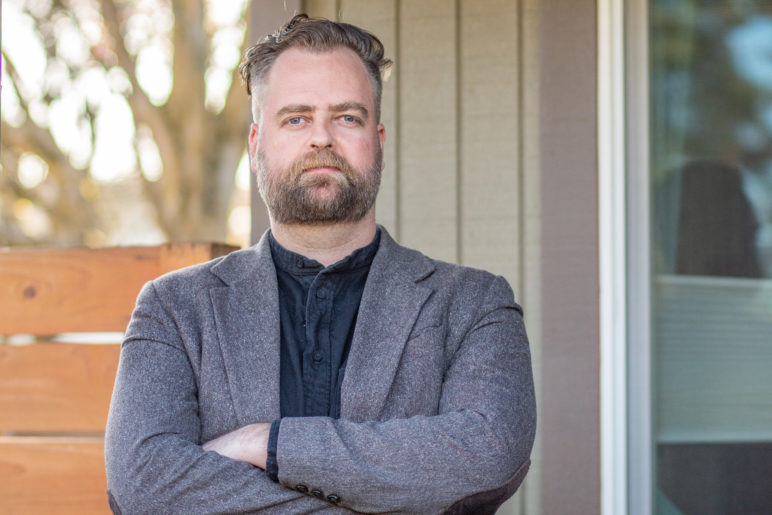
Former Portland Bureau of Planning and Sustainability staff economist Tyler Bump, outside his Portland home. Photo copyright Kayla Brock for Sightline.
Bump’s method may have been most interesting for what it didn’t do: It didn’t claim that making it easier to build homes in Portland would have any effect at all on the price of other homes.
That was an omission that seemed to contradict the consensus of real estate economists, that lowering land costs per home would lead within a few years to more homes and downward pressure on home prices. But it also reflected a reality: Many people both inside and outside Portland city government didn’t agree with the consensus of real estate economists.
The approach also erred on the side of caution, and reflected an empirical fact: When predictions about future market forces go awry, some neighborhoods tend to suffer more than others.
And the displacement analysis produced by the city estimated that some neighborhoods would, in fact, face bigger risks than others.
Because fourplex legalization would allow a smaller number of lots to accommodate a larger amount of housing growth, the reform would reduce demolition-related displacement of low-income renters by about 28 percent citywide, and by 21 percent in Census tracts facing the greatest risk of displacement.
However, the analysis also found that the proposed cap on building size had a subtle side effect. It shifted redevelopment pressure away from the highest-value areas and toward the city’s gentrification frontier. Largely as a result, five of the city’s 146 census tracts were projected to see between six and 20 additional low-income tenant households displaced over the next 20 years.
They weren’t the poorest neighborhoods in town. They weren’t the richest. But after the displacement report, they were suddenly at the center of the zoning reform conversation.
The long-awaited city report had accomplished two things:
- It had, improbably, been accepted as valid by almost every political faction.
- It had steered what might have been an irresolvable debate about ideology toward a search for solutions.
“If we came out and said there’s no displacement impacts whatsoever, this is all good, that would not have gone over,” Bump says. “That’s not realistic.”
Bump said the project’s success owes a major debt to Bates, a Portland State professor who had personally taught several of the city staffers on the report and many of the outside advocates. Years before she had been part of the Dingfelder meeting, Bates had started working with various Portlanders to develop both a qualitative definition of residential displacement and a quantitative method for the city to identify neighborhoods at risk. That agreed-upon framework, Bump said, gave all parties a place to start talking.
Still, no amount of research is a substitute for a good working relationship, he says.
“All of that is meaningless unless folks trust you and what you’re talking about,” Bump says. “And that goes both ways.”
Death #7: A displacement dispute makes the project radioactive
Prevented by Anti-Displacement PDX’s support for regulated affordable housing
The fact that the city had written a displacement report in the first place was no coincidence.
The report was a major accomplishment of a group called Anti-Displacement PDX. ADPDX was also the only organization with a stake in tenants’ interests that had been closely involved in the Residential Infill Project so far. It consisted mostly of a list of other organizations, many led by Portlanders of color, with a shared interest in housing stability.
“It’s not a very formal coalition,” says Julia Metz, an affordable housing developer and former ADPDX participant, of ADPDX’s status before 2020. “They don’t have ongoing meetings; there’s no agenda.”
But ADPDX did have a few important things:
- A record of success. After an intense, innovative political effort to mobilize testimony at the planning commission—a tactic Kovacs, too, would later use—ADPDX had recently persuaded the city to insert some 30 anti-displacement policies into its latest comprehensive land use plan. One of those strengthened the rule requiring displacement analysis of proposed zoning changes.
- A multiracial team of respected wonks. Bates, the Portland State professor; Pam Phan, a housing justice organizer who worked for both 1000 Friends and the Community Alliance of Tenants over the course of the project; Cameron Herrington, a tenant organizer in the Cully neighborhood; Danell Norby, who’d represented ADPDX on the infill project’s advisory committee; Oswill; and Metz were among active ADPDX participants.
- Perceived moral authority. This may have been ADPDX’s key power. Various leaders in an overwhelmingly liberal, overwhelmingly white-led city had implicitly decided, for whatever reason, that this organization was worth listening to and winning the approval of.
Herrington, who with Metz and Oswill was tracking the Residential Infill Project most closely, seemed particularly aware of that last fact. One thing it meant: ADPDX couldn’t afford to give out its approval lightly.
“He did not want us to say anything in meetings that the city could use as a rubber stamp,” Metz recalls. “In hindsight, I think that was a very smart thing to have in mind.”
Earlier in the project, Herrington, Metz, Oswill and Kovacs—all under 40 and all former grad students at Portland State—had begun meeting in the basement of Metz’s employer, Portland Community Reinvestment Initiatives (PCRI), to talk about ways to link anti-displacement measures with the residential infill project.
None of the four accepted an argument being made by many homeowners and a handful of tenants, that fourplex legalization would lead to mass gentrification and displacement.
“The far-fetched logical basis for that argument was that all of a sudden there are going to be people who are renting single-family homes who are somehow in a very stable situation, who aren’t already at risk of displacement, but because of the zoning change a developer might buy their house in order to build a fourplex,” says Herrington. The truth, he says, was that “maybe there’s some small number of renters who could be displaced a little earlier than they would have been displaced anyway by the next rent increase. Rejecting the zoning change would do nothing to prevent their eventual displacement. The only thing that could do that is to ensure that the zoning change results in more regulated affordable homes being built.”
So the four honed in on a different way to prevent displacement: a zoning code that would give a “leg up” to price-regulated housing projects, which could offer long-term stability for renters who would otherwise be priced out of their neighborhoods.
PCRI, Metz’s employer, was a Black-led housing nonprofit with an unusual stake in the matter. It had been created in 1991 to manage 352 lots acquired from the bankruptcy of a firm that had used balloon mortgages to fraudulently buy, sell, and then repossess the homes of many Black Portlanders in the 1980s.
By 2016, PCRI was looking for new ways to turn its inventory of low-density lots into stable housing, especially into no-strings-attached homeownership for Black Portlanders whose families had once lived in North and Northeast Portland. Metz and her colleagues realized that widespread plex legalization could help.
“We obviously did a lot of outreach among the Black and African American community,” Metz says. “It was just very clear that folks didn’t want to feel like they were living in an apartment building. They wanted a front door. They wanted to be able to stand on the street and say, ‘That’s my house.'”
Townhome-style triplexes and fourplexes were a way to give more people that feeling. They just needed to be legal. So Metz, a white woman working on behalf of PCRI and ADPDX, became affordable housing providers’ main advocate in the process.

Julia Metz, an affordable housing developer formerly with Portland Community Reinvestment Initiatives, outside her home. Photo copyright Kayla Brock for Sightline.
After the city’s displacement report came out, ADPDX’s role suddenly mattered even more.
That was due in large part to someone without close ties to ADPDX—the Residential Infill Project’s one persistent critic on the city planning commission: André Baugh.
Baugh grew up in the small city of Astoria, Oregon, in the 1960s and early 70s and became a salesman for wood and timber company Weyerhauser. He later joined Portland’s transportation bureau as a project manager before hanging his own shingle as a workplace diversity consultant in 2000.
Baugh, who owned a house in the same neighborhood as Dingfelder, felt the project had strayed too far from its origins as an anti-infill measure.
“It’s a new-age idea and the younger population tended to think it was a great idea and the older population didn’t,” Baugh says. “One of my neighbors said, Let me get this straight. There’s plenty of homes on our street — you’re telling me this could go fourfold? No, I don’t want that! You have to stop that!”
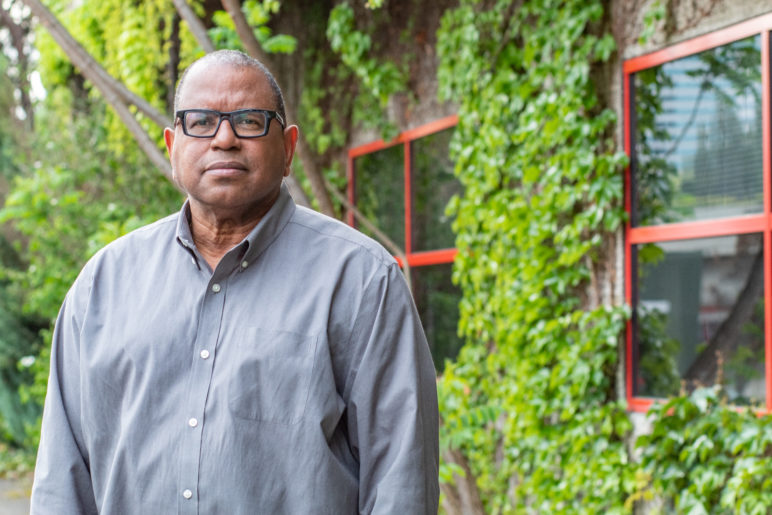
Former Portland Planning and Sustainability Commissioner André Baugh, outside his office. Photo copyright Kayla Brock for Sightline.
As for all the testimony at the hearings, Baugh says he felt it was important to weight the opinion of city-sanctioned neighborhood associations, most of which had opposed the reform, more than the opinions of the individuals and other institutions that had supported it.
Neighborhood associations “represent not 100 percent of their neighborhoods, but they do represent some portion of a neighborhood that has reached out to them,” Baugh says. “That is more important to me than the individuals.”
When the displacement report came out, Baugh found it very troubling that the project would increase projected displacement in some tracts. “We were putting them as expendables for the rest of the city,” he says. Though the analysis had found the plan would reduce displacement of low-income tenants citywide, and in displacement-risk areas, and in more than 80 percent of the tracts with the most Portlanders of color, Baugh argued that the good of some people doesn’t outweigh harm to others. The only Black person on the commission, he felt he couldn’t in good conscience let it pass.
On the afternoon of the planning commission’s final vote, Baugh didn’t hold back.
“RIP is displacement,” he said. “We are considered one of the whitest cities in Portland, and I think RIP really becomes, as I said before, institutional racism to create the whitest city.”
Baugh immediately became famous among the almost universally white testifiers against the project, who circulated video of his testimony.
Less quoted by opponents, but maybe more relevant to city politics, were the unexpected “no” votes of three other planning commissioners. Two of them, Teresa St. Martin and Daisy Quinoñez, were at that point the commission’s other two people of color. Their concerns were more ambivalent than Baugh’s—rooted largely in a belief that the planning commission hadn’t found enough ways to boost regulated-affordable housing.
“As a city, we must allow for a variety of housing forms to make housing within reach for more people, particularly people of color; RIP creates a pathway to this,” Quinoñez would later write. “While I understand the context that creates the need for RIP and the long-term benefits it can provide, I know that in the short term, such a zoning change can increase speculation and lead to displacement.”
The controversial project had advanced, but narrowly, with its key advisory body split over displacement concerns and all three planning commissioners of color voting against it.
If the city hadn’t had an engaged group of anti-displacement advocates, Portland’s council might have never found the energy to take up such a lightning rod.
But Portland did have an engaged group of anti-displacement advocates. And Anti-Displacement PDX’s members had different ideas than Baugh about where the project should go in its final stage.
Death #8: The project fails at city council
Prevented by a united coalition of pro-housing advocates
Around the time of the planning commission’s final debate, in early 2019, several other relevant things were happening.
- Minneapolis passed a similar reform. With an update to its own comprehensive plan, a different mid-size liberal city re-legalized triplexes on any lot. A wave of praise for the concept shot through the national media.
- The state weighed in. Motivated in part by Portland’s slow progress, Oregon House Speaker Tina Kotek moved a bill through Oregon’s legislature that required all larger cities to reform their low-density zoning. Though Kotek’s bill was less ambitious than the city’s proposal by that point, the state law removed perhaps the single likeliest possibility: that nothing at all might happen. It also removed a major way to gut the project: allowing attached homes but only at below-market prices that would rarely be achieved.
- Advocates re-organized. Kovacs left Portland for Everyone to focus on state-level advocacy. Her departure from the role led the volunteers she’d mobilized, along with Kovacs herself, to form a new volunteer organization that she’d envisioned for years: a pro-infill organization that also vocally supported strengthening tenant protections. The new group called itself “Portland: Neighbors Welcome.” Its organizers, including Kovacs, Henry Kraemer, and Tony Jordan, helped rally council testimony for two big goals of tenant advocates: new rules for how landlords could screen potential tenants and a “tenant opportunity to purchase” program for when rental buildings change hands.
- Advocates started to collaborate more closely. Kovacs’ successor at Portland for Everyone, Sam Diaz, joined with Phan, Herrington, and P:NW organizer Holly Balcom to convene two “big tent” housing advocacy meetings. For the first time, many of the people behind Anti-Displacement PDX, Portland for Everyone, and Portland: Neighbors Welcome were in the same rooms at the same time. Using a modified dot-voting system and much debate, the several dozen housing advocates honed several ideas and found consensus around a new one that had just been approved in Austin: legalizing up to six below-market homes per lot.
- City Hall made new hires. In summer 2019, the project’s main champion, Mayor Ted Wheeler (who had succeeded Hales in 2017), recruited Diaz away from Portland for Everyone and gave him a mandate to get the project passed. The most left-leaning infill skeptic on the council, Chloe Eudaly, hired Oswill, the former planning commissioner and a believer in the reform, as her lead housing advisor. Another potential swing council vote, Jo Ann Hardesty, hired Derek Bradley, another reform supporter and a close friend of Kraemer’s.
Some new faces also arrived outside City Hall. One was a new lobbyist for the regional homebuilders association, Ezra Hammer, who had previously been active in the Los Angeles-area YIMBY movement. Hammer, too, came to the “big tent” meetings and threw himself into the project even though only a few of his members were building small plexes.

Sam Diaz, a former Portland for Everyone coordinator and subsequent policy advisor to Mayor Ted Wheeler, outside his home. Photo copyright Kayla Brock for Sightline.
Diaz mentions two things that motivated so many people to attend the meetings he co-organized: an earnest desire to get the policy right, and the close planning commission vote.
“We checked in with each other to be like, how do we strengthen this proposal and address some of the concerns that were raised?” he says. “Because of that authentic concern, we were able to keep the relationship and keep the trust around a really diverse group of people.”
The wind seemed to be at infill advocates’ back. But the left wing of Portland’s council, Eudaly and Hardesty, wouldn’t commit their votes. Eudaly, facing a re-election challenge against an anti-infill candidate, said she supported the goals of the plan but worried about its unintended costs. She had publicly committed to voting “no” without further amendments to reduce displacement. Mayor Wheeler opposed linking the zoning reform to any new expenditure, and was quietly skeptical of the “tenant opportunity to purchase” program Eudaly wanted. Then, two weeks before the scheduled public hearing, Mayor Wheeler’s closest ally on the council died after a battle with cancer. Nick Fish’s death left four people on Portland’s council and one, Amanda Fritz, was staunchly opposed. After five years, the project still needed three votes—and was still hanging by a thread.
Everything depended on finding a new amendment that could satisfy all potential supporters. Fortunately, the increasingly unified coalition of housing advocates had been working on one.
Infill advocate Neil Heller, who worked for a small development firm, had been toying with numbers. How much could zoning reforms reduce the amount of public subsidy required to create a price-regulated home? Kovacs convened a meeting with Heller, various coalition members, and several affordable housing developers. The group hammered out a concept: if the buildings were large enough, legalizing six homes per lot would make it plausible for a nonprofit builder to create price-regulated homes on any buildable lot in the city.
Those calculations opened the door to a new compromise. The city could plausibly require below-market homes in any projects that chose to build more than four homes per lot. There was just one catch: The city council would need to legalize more than four homes per lot.
Drawing on their relationships in City Hall, P:NW and ADPDX set up joint meetings to shop the amendment around. Council staffers were pleased to see the groups working together, but skeptical that such an idea could pass.
But a last-minute sixplex amendment had several big advantages:
- It offered Eudaly the concrete win she’d insisted on.
- It gave housing advocates a new incentive to show up and testify.
- It deprived anti-infill testifiers of their most respectable talking point: that the reform did nothing for “truly affordable” housing.
Herrington and Oswill, meanwhile, had been working with Diaz on a related deal: a commitment for the city to actually dedicate planning staff to developing a “tenant opportunity to purchase” program.
To prepare for the crucial hearing, P:NW organizers mobilized two dozen volunteers to show up an hour before sign-ups started. Once the sign-up sheet was posted, the volunteers registered the names of other key testifiers before going back through the line and signing up for slots of their own. They distributed sheets of talking points with an outline of the coalition platform.
ADPDX and P:NW still weren’t asking for exactly the same things; ADPDX continued to push for other programs beyond the zoning reforms and the tenant purchasing program endorsed by P:NW, including new fees and waivers to incentivize and subsidize price-regulated homes. But neither faction seemed interested in calling attention to their differences. They agreed on enough.
One group, the Cully Housing Action Team mobilized by Herrington, delivered a definitive bit of public testimony. When their speakers’ names were called, a dozen other members filed silently into the council chambers holding signs aloft: “Yes to RIP / Yes to Affordability Amendments.” Their designated speakers then delivered a multilingual paean to renter protections and affordable infill—first one in English from a white man about the zoning-segregated neighborhoods of his childhood, then one in Spanish from a Latina priced out of a recently purchased apartment building who’d found a nearby home in an accessory dwelling unit.
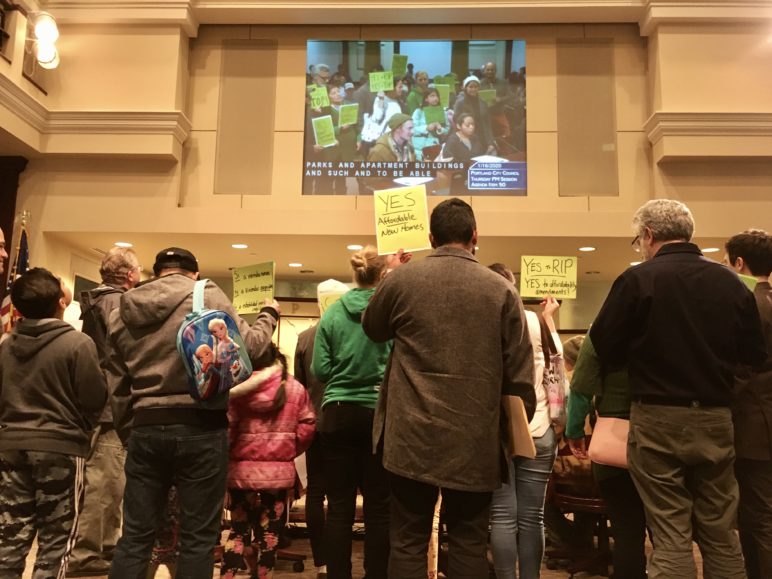
Jake Antles speaks as part of a testimony and silent demonstration by the Cully Housing Action Team. Photo: Michael Andersen for Sightline.
Finally Malin Jimenez, an organizer for the environmental justice nonprofit Verde who’d been displaced from north Portland to a suburb, closed her testimony this way:
“Even though I had a stable job, I couldn’t afford to live in the neighborhood where I work. We need more apartments. We need more ADUs and duplexes. And we need units that can be affordable for immigrants, people of color, Black communities, low-income families, and community organizers like me. Yes to new homes; yes to affordable new homes; and yes to stability for renters.”
The hearing went on. But after that, the debate was over.
Our thanks to the Lincoln Institute for their partnership and to Kayla Brock for capturing the portraits included above. Thanks to Paavo Monkkonen, Cameron Herrington and Jessie Grogan for reviewing drafts of this history.










Michael
“Baugh, who owned a house in the same neighborhood as Dingfelder, felt the project had strayed too far from its origins as an anti-infill measure.”
I think ‘anti-infill’ is the wrong word here. Perhaps ‘anti-displacement’ or ‘pro-infill’?
Michael Andersen
What Baugh told me was that (as recounted in the first “death” described here) the project had started out as a way to prevent demolitions of old buildings. (Demolitions that were being done to replace old buildings with new buildings.) He felt that was the legitimate origin of it.